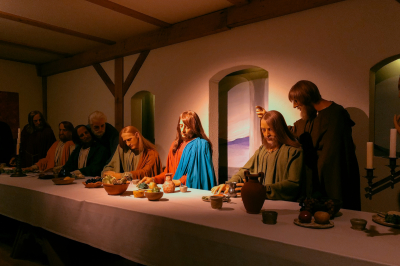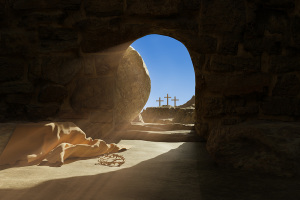Why 'virtual Lord’s Supper' is impossible

On March 30 I turned 40, and because of “stay in place” requirements, my wife hosted a surprise Zoom birthday celebration. About 20 people logged on, they sang “Happy birthday” (which didn’t go well, but was hilarious), and it was a really nice brief chance to see a lot of friends and family since we couldn’t have the birthday party in our home that my wife had been planning.
You know what we didn’t do? We didn’t try to eat together.
I completely understand the underlying desires that fuel churches who are encouraging their congregation to celebrate the Lord’s Supper at home “virtually” during this period of quarantine. We miss being together. The Lord’s Supper is an important element that Christ himself prescribed for corporate worship. And especially if your church celebrates the Table frequently, as our church does, not observing it for an extended period of time is weird and uncomfortable. I get it.
But “virtual Lord’s Supper” is impossible. Here’s why:
Physical togetherness is essential to what the Table communicates.
I’ve seen some people say that the purpose of the Table is to “proclaim the Lord’s death until he comes” (1 Cor 11:26), and that this can be done virtually through technology. It is certainly true that the Table proclaims Christ’s death, and if that were all that it did, I might agree that this can be done virtually.
However, proclaiming the Lord’s death is not all that the Table does; in fact, I would argue that it is not even primarily what the Table does.
Many things proclaim the Lord’s death, some of which can be done inside or outside corporate worship, when the church gathers or in other contexts. Preaching, teaching, Scripture readings, song lyrics — each of these can and should proclaim Christ’s death. And the Table does too.
But the Table does far more than that — the Table uniquely pictures and nurtures the communion that we as the Body of Christ enjoy with Christ as a result of the Lord’s death on behalf of those who believe.
Paul clearly states this in 1 Corinthians 10:16:
The cup of blessing that we bless, is it not a participation in the blood of Christ? The bread that we break, is it not a participation in the body of Christ?
The word translated “participation” there is the term koinonia — “communion.” Because of Christ’s death — because of his broken body and shed blood for the forgiveness of sins — those who believe are united to Christ and thus experience true communion with him.
But not only that, believers who are united to Christ enjoy communion with each other as the Body of Christ as well, and this too is uniquely communicated in the observance of the Table. Paul says so in verse 17:
Because there is one bread, we who are many are one body, for we all partake of the one bread.
Partaking of the one bread is an essential part of the picture of communion shared by the Body, and this is possible only with physical presence. This is exactly why when Paul returns to discussing the Lord’s Supper in 1 Corinthians 11, he repeatedly refers to “when you come together.” Notice the frequent occurrence of that phrase in the context of giving instructions regarding the Table:
v. 17: “when you come together”
v. 18: “when you come together as a church”
v. 20: “when you come together”
v. 33: “when you come together to eat”
v. 34: “when you come together”
This physical togetherness is fundamentally essential to the drama of the meal — the Supper pictures communion of the body exactly through the physical, embodied acts done around the Table, especially partaking of the one bread. These embodied acts —the very essence of the observance — are impossible without coming together physically. And thus the corporate gatherings of the church are fundamentally different realities from other times when the church is not gathered physically.
In fact, in this context, Paul explicitly contrasts eating the Lord’s Supper when we come together as the church with eating in private homes (v. 22) — they are not the same thing, because when we eat privately in our homes, we are not gathered as the church.
And the Table not only pictures communion of the Body through the Lord’s death, it also enacts that communion through the physical actions. It is a biblical “memorial” —anamnesis. A biblical memorial is a ritual reenactment of a spiritual reality such that those who participate are shaped by that reenactment.
A perfect example of this in the Old Testament was the Passover. Passover was a corporate worship service that enabled God’s people to literally reenact God’s deliverance of his people in the Exodus from Egypt — that’s why God calls it a “memorial.” He wanted his people to regularly observe this memorial, including physically acting out various aspects of the first Passover, so that they would remember his deliverance of them and, perhaps even more importantly, be shaped by that remembrance as they reenact the first Passover.
Fifteenth hundred years later, while observing the Passover himself, Jesus Christ established a similar reenactment and commanded his disciples, “Do this in remembrance of me.” This new Christian memorial serves the same function for the church as Passover did for Israel — it shapes Christians by a remembrance of Christ as we physically reenact his broken body and shed blood, and as we physically embody the communion accomplished by his death.
This is why when our church celebrates the Supper, our congregation surrounds the Table, beautifully picturing what the Lord’s Supper is supposed to communicate —communion together around Christ.
This is also why Paul specifically condemns divisions within the body in this context. Paul calls observing the Lord’s Supper while there are divisions within the Body eating and drinking “in an unworthy manner.” Why is it unworthy? Because observing the Table while there are divisions destroys the very image the Table is meant to communicate — communion of the Body.
In other words, we shouldn’t observe the symbol of communion when there is no actual communion.
I’m thankful for technology, especially during this unusual time when churches are unable to meet for a while. I’m thankful that it allows us to stay somewhat connected and that I can provide resources for our church families to read Scripture, sing, and listen to a recorded sermon at home.
But some things technology cannot accomplish. And since physical togetherness is inherently part of what the Lord’s Supper is meant to communicate, I believe it would be a mistake to try to “replicate” the Table virtually through technological means. In fact, you can’t. You can eat and drink; you may even be able to proclaim the Lord’s death. But you can’t have Communion without coming together.
Instead, let’s long for the day when our churches will be together physically again, and at that time, let’s display our deep joy of renewed communion with one another, centered on Christ, by using the most beautiful picture Christ has given us to do so —his Table.
Scott Aniol, PhD, is an author, speaker, and teacher of culture, worship, aesthetics, and church ministry philosophy. He is chair of the Worship Ministry Department at Southwestern Baptist Theological Seminary. He founded Religious Affections Ministries and has written several books, the most recent being By the Waters of Babylon: Worship in a Post-Christian Culture. He can be found on Twitter @ScottAniol, and you can listen to his podcast here.




























